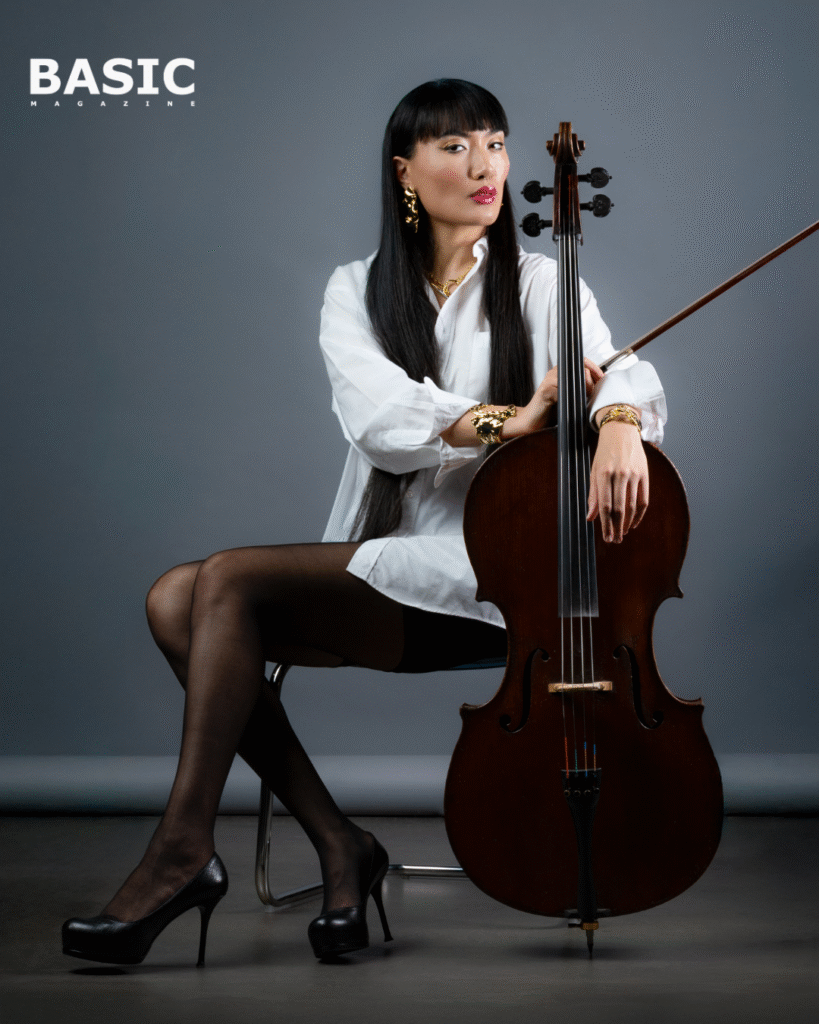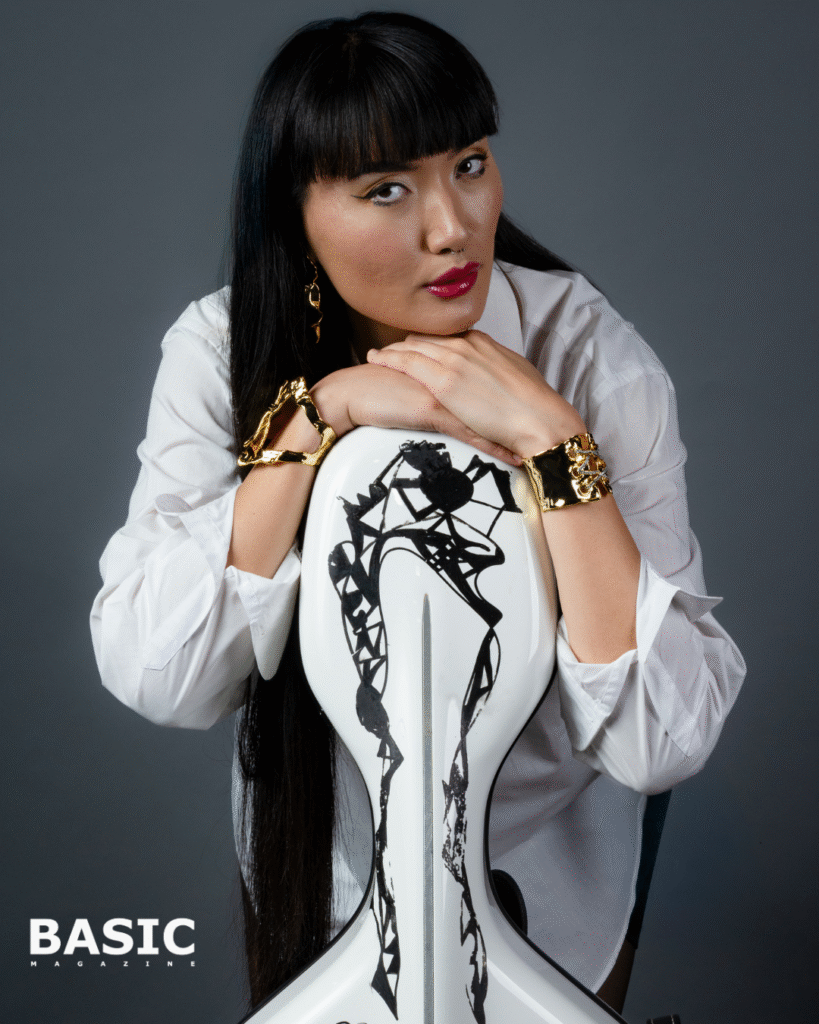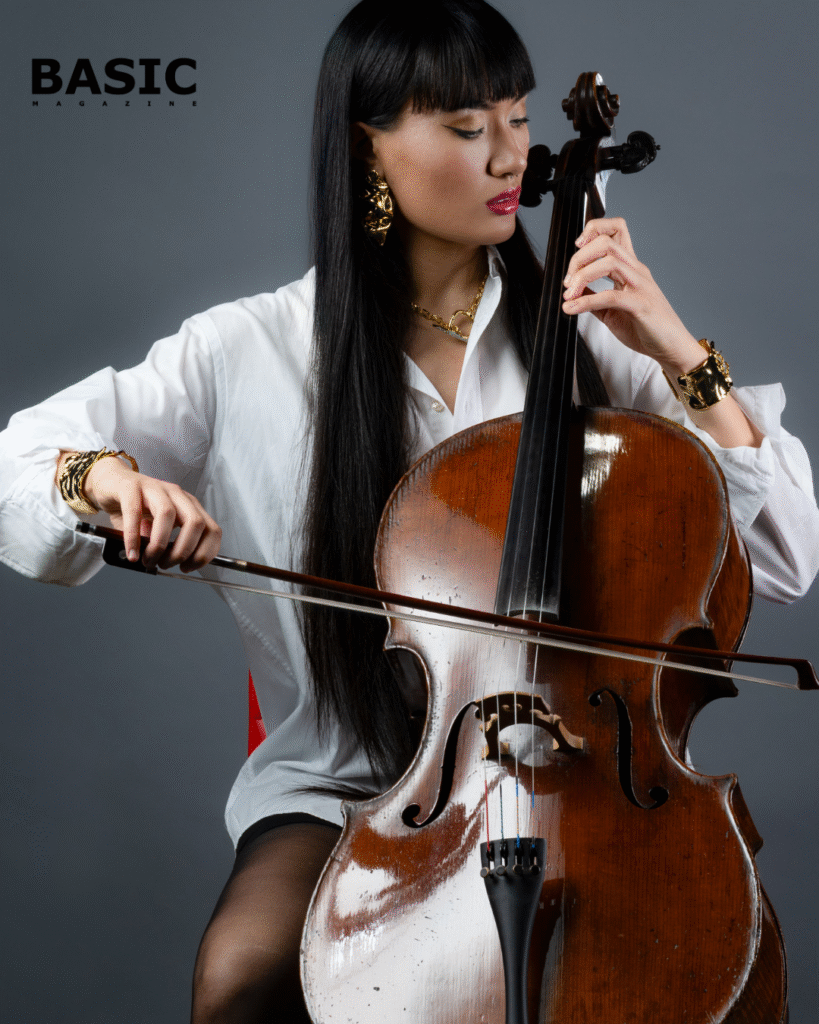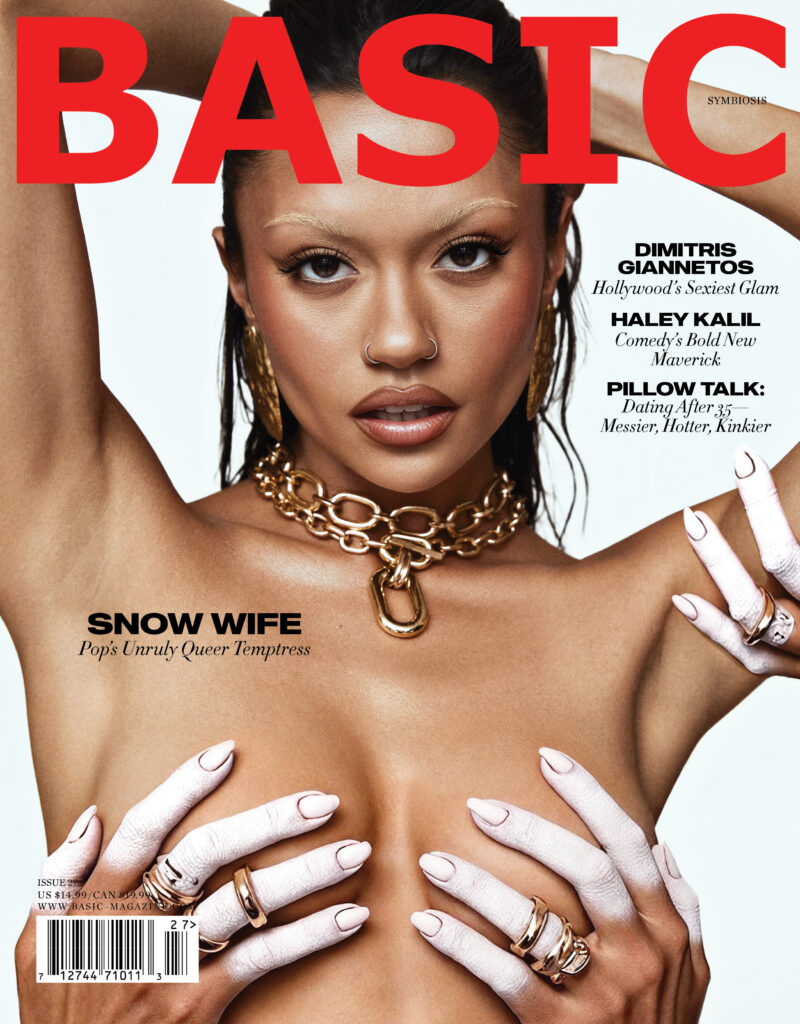Photography by Jathan Campbell

Sophia Bacelar, better known to the world as Suuvi, was born in the United States, absorbed in the cultural heritage of her Spanish and Mandarin- speaking parents. Her father, a talented cellist, was determined that his daughter would follow in his footsteps, and by the age of two, Suuvi was already learning the cello. Meeting his high expectations wasn’t always easy, but she acknowledges the pivotal role her father’s disciplined approach played in shaping her sound and intonation. Now, as a multidisciplinary artist, composer, and producer, she draws on her extensive training to create music that resonates with a wide range of people and causes.
Her path, though seemingly direct, included struggles with isolation and severe bullying at school due to her unique background and appearance. At age 10, her acceptance into Juilliard marked a turning point, freeing her from the traditional American education system to explore her life independently. Her teenage years in Paris and Berlin immersed her in European culture, and returning to the U.S. in her 20’s brought unexpected culture shock, overwhelmed by the sheer variety and choices in something as simple as a grocery store.
Suuvi spent a long time feeling uncertain about her identity and where she truly belonged, yet what once felt like a struggle to fit in has become her muse. In this intimate conversation Suuvi opens up about how these cross-cultural experiences have shaped her narrative, learning to trust her own decisions, and the conceptual process of Dark Therapy, a compilation of music for deeper introspection and emotional release.

Your work is deeply rooted in storytelling. Can you share a specific project or performance where storytelling played a central role, and what narrative you aimed to convey?
One of the most special works I’ve had the opportunity to create is “BLOQUEA’O,” a piece that tells the story of the Cuban immigrant experience in America. My father was a political refugee from Cuba, and I wanted to honor his heritage and journey, as well as showcase the sound and spirit of Cuban music. The entire piece is composed of 12 layered cello parts, Cuban percussion, and electronics, infused with field recordings from the streets of Cuba, Cuban poetry, and political speeches from JFK and Fidel Castro.
As a social impact advocate, what role do you believe art plays in addressing societal challenges?
I always say that artists are like diplomats. We have a unique position in society that allows us to cross borders and build bridges between very disparate parts of the world—socially, economically, culturally, and geographically. Art has the power to transcend conflict and foster unity through its ability to touch and impact people on a very primal and emotional level. There is a universality to art that can bring together people who might not realize they have anything in common, and finding and bonding over those shared threads is very important to me. I believe artists have a certain responsibility to be somewhat aware of what they are creating and how it affects those who consume it. I’ve tried to become more conscious of what I create and the message it carries as I grow and mature as a human. I always want to make sure the impact I’m having is a net positive on the world, whether through its narrative and messaging, or where it will appear and who will be involved in presenting it.
Art often reflects personal growth. Can you share how your artistic journey has contributed to your own self-actualization and understanding of humanity?
The early part of my artistic journey was reflective of who I was at a time when I was studying in a conservatory and trying to impress academic juries who assessed my work based on fairly predefined parameters of value. Once I entered the real world, I was no longer interested in making music this way and wanted to start utilizing my own voice. I wouldn’t have been able to do this without first gaining the experience and skills I acquired through conservatory and classical music, but I never felt self-actualized in my work until I started writing my own music, creating projects driven by my personal ideals and mission, and shaping my own narrative.
Can you take us back to the moment when you realized Hans Zimmer wanted you for his live show?
When I got the cold email asking me to be in Hans Zimmer’s show, I was still a student at Juilliard, although I’d already been performing as a classical soloist globally for several years. I knew very little about film music and accepted the invitation without really knowing what I was doing. Afterward, I moved to L.A., where I immediately immersed myself in learning about music technology, production, and how to make every genre of music I could discover that wasn’t classical music. Coming from 16 years of classical conservatory training, it felt like being raised Amish and suddenly being shown what electricity was.

Reflecting on your extensive training and diverse experiences, what philosophy guides your art, and how do you balance the discipline of classical training with the freedom of contemporary expression?
I am incredibly grateful for my classical training, as it gave me a competitive edge and a deep foundation of structure, knowledge, and discipline—both as a musician and an individual. However, it has also been something I’ve had to challenge the most in my post-classical era as an artist. One of the most difficult things I’ve had to unlearn is the need to seek approval and permission. In the classical world, there is very much a right and wrong way of doing things, with little leeway in how you make music “correctly.” In my early days of producing non-classical music, I struggled with the creative freedom I suddenly had and couldn’t trust my own decisions. It felt like I was a caged animal being told it could leave and go wherever it wanted. I wanted to explore and discover new ways of making music, but I was also terrified of going down a path where nobody was validating whether I was doing things correctly or not.
I’d love to hear more about the conceptual side of Dark Therapy. Could you describe the creative process you underwent in developing this album, especially in relation to your mental health experiences?
After a series of traumatic events impacted me and my family in my early 20s, I experienced a profound mental breakdown that culminated in a suicide attempt when I was 23. I spent the next five years navigating a mental health crisis and healing through my study of neuroscience, meditation practice, and lifestyle changes—including complete sobriety. Last summer, I did my first 10-day silent Vipassana meditation retreat. I spent the majority of my 11.5-hour daily meditation sessions in a meditation cell, which was a completely dark room with nothing but a cushion on the ground. It was the first time I had ever taken a true break from my life, and the sensory deprivation and lack of external stimuli launched me into a deep introspective reflection upon the 28 years of life I’d lived. When I came out of the retreat, I realized what a powerful and life-changing experience I’d had and how important taking the time to pause and go through the shadow work I did during those 10 days was for my personal growth. I wanted to encapsulate the experience I had in a sonic journey others could create at home for themselves, and wrote Dark Therapy as a soundtrack for sitting in the dark, going inward, and finding emotional release. I collaborated with the Institute for Advanced Consciousness Studies to create compositions that mirror heartbeat rhythms and the body’s natural cadence. Using tonalities that evoke emotional resonance and harmonic tension to aid psychological release, the music is designed to enhance interoceptive awareness. My hope is that listeners leave feeling more grounded, self-aware, and emotionally unburdened.
In what ways did creating Dark Therapy serve as a therapeutic process for you, and how do you hope it will resonate with listeners who are on their own paths to healing?
For a long time, I had a conflicted relationship with the cello. I’d devoted my entire life to mastering the instrument, but I often questioned whether that devotion was ever truly my choice or if I had pursued this career to meet the expectations of my parents. I grew up chasing perfection, but much of that drive was entangled with the need to earn my parents’ approval. That tension—between my own identity and the one shaped for me—was at the root of a lot of personal pain I’ve spent years working to heal. After many years of climbing the ranks of the classical music world, I made the difficult decision to walk away from it right after my Carnegie Hall debut and graduating from Juilliard. It was a deeply disorienting moment. I had to face not only the weight of the sunk cost fallacy but also the confusion of those who couldn’t understand why I chose to step back. The harder question for me personally was whether I’d ever play the cello again. On one hand, I had come to associate it with a life that had made me deeply unhappy—but it was still the one thing I had committed to more fully than anything else in my life, and I had a suspicion that, deep down, I did love it. Writing Dark Therapy became a turning point as it allowed me to reconnect with the cello—not as a tool for validation, but as an extension of my voice. By stepping outside of classical music and allowing myself to create something entirely original with my instrument, I realized I didn’t need to reject my past to reclaim my future. It wasn’t the cello I needed to leave behind, but the narrow definition of what a cellist was allowed to be. Dark Therapy gave me the freedom to redefine that on my own terms—and in doing so, to reclaim my creative agency and my sense of self. My hope is that this project offers others a mirror for their own journeys and reminds them they have the power to rewrite their story—even the chapters they once thought were failures or detours. There was once a time when I felt that all the years I’d spent in a practice room were a waste of my life and a source of deep regret and frustration. Now, I know that they are the underpinning that set me up for everything I do today.

BUY ISSUE 27
You may also like
-
ANNA KOSKAROVA: To Be Seen is a Universal Love Language
-
Isn’t It Funny? HALEY KALIL’S Unscripted Story
-
Staying Loud, Staying True: Spacey Jane’s Evolution from Perth to the World
-
Reframing Narratives with KATHERINE FLYNN
-
FIGHT TO THE OTHER SIDE: Hilary Roberts on Suffering, Freedom, and Sharing her Mafia Gifts
-
SEXY 4EVER – An Interview with INJI
